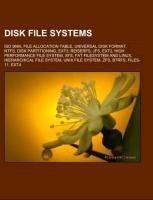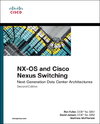
-
 Anglický jazyk
Anglický jazyk
Disk file systems
Autor: Source: Wikipedia
Source: Wikipedia. Pages: 101. Chapters: ISO 9660, File Allocation Table, Universal Disk Format, NTFS, Disk partitioning, Ext3, ReiserFS, JFS, Ext2, High Performance File System, XFS, FAT filesystem and Linux, Hierarchical File System, Unix File System,... Viac o knihe
Na objednávku
22.70 €
bežná cena: 25.80 €
O knihe
Source: Wikipedia. Pages: 101. Chapters: ISO 9660, File Allocation Table, Universal Disk Format, NTFS, Disk partitioning, Ext3, ReiserFS, JFS, Ext2, High Performance File System, XFS, FAT filesystem and Linux, Hierarchical File System, Unix File System, ZFS, Btrfs, Files-11, Ext4, HFS Plus, Disc Filing System, Reiser4, Amiga Fast File System, NTFS junction point, Volume, Hard link, Veritas File System, Advanced Disc Filing System, Installable File System, Amiga Old File System, Drive Letter Access, Universal Disk Format builds, Be File System, Log-structured File System, NTFS reparse point, NILFS, MINIX file system, NTFS-3G, JFFS2, Steganographic file system, Hybrid disc, Write Anywhere File Layout, Macintosh File System, AdvFS, Ntfsprogs, Tux3, POHMELFS, LogFS, Partition type, NTFS symbolic link, Ext3cow, Novell Storage Services, Smart File System, NetWare File System, SyMon Bootmanager, Fossil, Acronis Secure Zone, Basic data partition, TRANS.TBL, E2fsprogs, Xiafs, Captive NTFS, HP StorageWorks Scalable File Share, File control block, Professional File System, StegFS, Nasan, Journaling block device, Extended file system, Volume serial number, High Sierra Format, CrossDOS, AtheOS File System, FATX, Htree, Veritas Cluster File System, SpadFS, ZFS+, QNX4FS, EXOFS, Episode filesystem, Boot File System, Slice, Partition table, Allocation group, ISO 13490, Ext2IFS, Extent File System, PCFS, Hi Performance FileSystem, Opera File System. Excerpt: File Allocation Table (FAT) is a computer file system architecture now widely used on many computer systems and most memory cards, such as those used with digital cameras. FAT file systems are commonly found on floppy disks, flash memory cards, digital cameras, and many other portable devices because of their relative simplicity. FAT was also commonly used on hard disks throughout the DOS and Windows 9x eras, but its use on hard drives has declined since the introduction of Windows XP, which primarily uses the newer NTFS. The name originates from the usage of a table which centralizes the information about which areas belong to files, are free or possibly unusable, and where each file is stored on the disk. To limit the size of the table, disk space is allocated to files in contiguous groups of hardware sectors called clusters. As disk drives have evolved, the maximum number of clusters has dramatically increased, and so the number of bits used to identify each cluster has grown. The successive major versions of the FAT format are named after the number of table element bits: 12 (FAT12), 16 (FAT16), and 32 (FAT32). Each is still in use. The FAT standard has also been expanded in other ways while generally preserving backward compatibility with existing software. For floppy disks, the FAT has been standardized as ECMA-107 and ISO/IEC 9293. These standards cover FAT12 and FAT16 without long filename support; long filenames with FAT are partially patented. The FAT file system is technically simple and supported by virtually all existing operating systems for personal computers. This makes it a useful format for solid-state memory cards and a convenient way to share data between operating systems. Designed and coded by Marc McDonald, Microsoft Stand-alone Disk BASIC introduced the FAT in 1977 with 8-bit table elements, produced for NCR's 8-bit 8080 file system. The FAT, born during one of a series of discussions between McDonald and Bill Gates, was later used in a stand
- Vydavateľstvo: Books LLC, Reference Series
- Rok vydania: 2012
- Formát: Paperback
- Rozmer: 246 x 189 mm
- Jazyk: Anglický jazyk
- ISBN: 9781156442159

 Nemecký jazyk
Nemecký jazyk 










